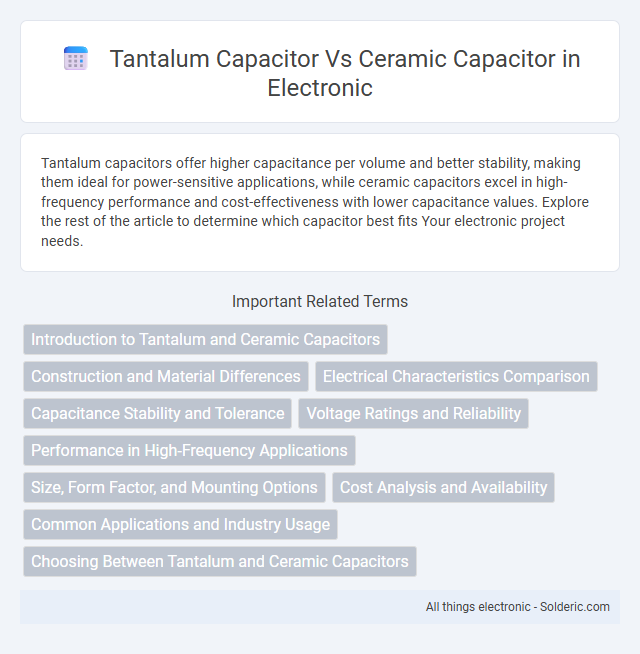Tantalum capacitors offer higher capacitance per volume and better stability, making them ideal for power-sensitive applications, while ceramic capacitors excel in high-frequency performance and cost-effectiveness with lower capacitance values. Explore the rest of the article to determine which capacitor best fits Your electronic project needs.
Comparison Table
| Feature | Tantalum Capacitor | Ceramic Capacitor |
|---|---|---|
| Material | Tantalum Metal Powder | Ceramic Dielectric |
| Capacitance Range | 0.1 uF to 470 uF | 1 pF to 100 uF |
| Voltage Rating | Up to 50V typically | Up to 1 kV or higher |
| ESR (Equivalent Series Resistance) | Low ESR, Stable | Very Low ESR |
| Temperature Stability | Good, but limited by electrolyte | Excellent, varies with class (C0G, X7R) |
| Physical Size | Smaller for given capacitance | Compact, varies with capacitance |
| Polarity | Polarized | Non-polarized |
| Applications | Power supply filtering, decoupling | RF circuits, general purpose, decoupling |
| Cost | Higher cost | Lower cost |
| Reliability | Moderate; sensitive to surge current | High; robust under stress |
Introduction to Tantalum and Ceramic Capacitors
Tantalum capacitors feature a solid electrolyte, offering high capacitance in a compact size and excellent stability over temperature and frequency. Ceramic capacitors use a ceramic dielectric material, providing low equivalent series resistance (ESR) and high reliability, especially in high-frequency applications. Your choice between tantalum and ceramic capacitors depends on specific requirements such as voltage rating, capacitance value, and performance under varying operational conditions.
Construction and Material Differences
Tantalum capacitors feature an anode made from tantalum metal, coated with a thin oxide layer serving as the dielectric, and use a solid or liquid electrolyte, delivering high capacitance in a small volume. Ceramic capacitors consist of ceramic materials as the dielectric with metal layers forming electrodes, offering low equivalent series resistance (ESR) and excellent high-frequency performance with varied dielectric compositions like NP0, X7R, and Y5V. Understanding these construction and material differences helps you select the right capacitor type for specific applications requiring stability, capacitance density, or frequency response.
Electrical Characteristics Comparison
Tantalum capacitors offer stable capacitance with low Equivalent Series Resistance (ESR) and excellent volumetric efficiency, making them suitable for low-frequency, high-reliability applications. Ceramic capacitors exhibit lower capacitance values but provide superior high-frequency performance, low inductance, and high insulation resistance, ideal for filtering and decoupling tasks. While tantalum capacitors maintain stable capacitance under varying temperatures and voltages, ceramic capacitors may experience capacitance variation due to their dielectric material properties (Class 2 or Class 3 dielectrics).
Capacitance Stability and Tolerance
Tantalum capacitors provide superior capacitance stability over a wide temperature range compared to ceramic capacitors, which may experience significant capacitance variation under thermal stress. The tolerance of tantalum capacitors is typically tighter, often within +-10% to +-20%, offering more predictable performance in precision circuits. Understanding these differences helps you select the ideal capacitor type for applications requiring consistent capacitance values and reliability.
Voltage Ratings and Reliability
Tantalum capacitors typically offer higher voltage ratings up to 50V or more with stable capacitance and low Equivalent Series Resistance (ESR), making them suitable for applications requiring consistent performance under stressed conditions. Ceramic capacitors generally have lower voltage ratings, usually up to 25V, though advanced Class II and III types can reach higher voltages, their reliability can be impacted by microcracks caused by mechanical stress. The inherent reliability of tantalum capacitors stems from their sintered tantalum anode and solid electrolyte, providing excellent long-term stability, whereas ceramic capacitors may experience capacitance loss and aging effects over time, especially under high voltage or temperature cycling.
Performance in High-Frequency Applications
Tantalum capacitors offer stable capacitance and low Equivalent Series Resistance (ESR), making them suitable for moderately high-frequency applications where reliability is critical. Ceramic capacitors, particularly multi-layer ceramic capacitors (MLCCs), excel in high-frequency performance due to their low parasitic inductance and capacitance, enabling fast response times and minimal signal loss. Your choice between tantalum and ceramic capacitors depends on the specific frequency range and performance requirements in your electronic circuit design.
Size, Form Factor, and Mounting Options
Tantalum capacitors typically offer smaller sizes and higher capacitance per volume compared to ceramic capacitors, making them suitable for compact circuit designs where space is limited. Their form factor is often a cylindrical or rectangular shape with axial or surface-mount packaging, providing versatile mounting options like through-hole or surface-mount technology (SMT). Your choice depends on the design's size constraints and mounting preferences, as ceramic capacitors generally come in flat, chip-style packages optimized for SMT on printed circuit boards.
Cost Analysis and Availability
Tantalum capacitors generally have a higher cost compared to ceramic capacitors due to their complex manufacturing process and use of rare materials like tantalum metal. Ceramic capacitors are widely available and produced in large quantities, offering an economical choice for many electronics applications. When managing your budget and supply chain, ceramic capacitors often provide better cost efficiency and availability than tantalum alternatives.
Common Applications and Industry Usage
Tantalum capacitors are commonly used in aerospace, medical devices, and telecommunications due to their stable capacitance, high volumetric efficiency, and reliable performance in harsh environments. Ceramic capacitors are preferred in consumer electronics, automotive systems, and industrial equipment for their low cost, high frequency characteristics, and excellent temperature stability. Your choice between tantalum and ceramic capacitors depends on application-specific requirements such as size, operating voltage, and environmental conditions.
Choosing Between Tantalum and Ceramic Capacitors
Tantalum capacitors offer high capacitance with stable performance in compact sizes, making them ideal for power-sensitive applications requiring long-term reliability. Ceramic capacitors provide excellent high-frequency characteristics and low equivalent series resistance (ESR), suited for decoupling and filtering tasks where transient response is critical. Your choice between tantalum and ceramic capacitors should consider factors like voltage rating, capacitance stability under temperature, size constraints, and cost efficiency for your specific electronic design.
tantalum capacitor vs ceramic capacitor Infographic

 solderic.com
solderic.com